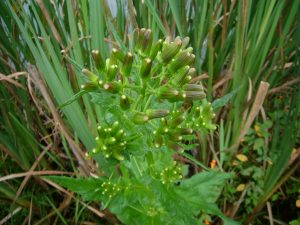
Chamerion angustifolium is the prettier of the two fireweed/burnweeds.

The other Burnweed in blossom. Photo by Green Deane
Having two different edible plants both called Fireweed and Burnweed can be confusing. This species is showy, a tall wildflower with noticible pink flowers. The other is not showy at all, in fact its greenish flower barely open, see photo right. You won’t confuse the two in person though some of their territories overlap. For the other one see a separate entry under Burnweed which is Erechtites hieracifolia, the wallflower of the two.
Fireweed is call that because it is ruderal, that is, it takes advantage of burned ground and sprouts soon after a fire scorches through. It can tolerate bombing and volcanos. When London was blitzkreiged in WWII Fireweed was one of the first flowers to emerge from the rubble. It was also the first blossom to appear after Mt. St. Helens blew her top in the spring of 1980. In the Evening Primrose family, it was in the genus Epilobium but was recently changed (as are so many plants now that DNA testing tells us botanists really got it wrong… an often.) Now it is Chamerion angustifolium.
Nutritionally fresh Fireweed shoots have per 100 grams 20 calories, 0.3 grams of protein, 0.4 grams of fat, 6.4 grams of carbohydrates, and 0.8 grams of fiber. They have 32 mg of calcium, 31 mg of phosphorus, 20 mg of magnesium, 0.7 mg zinc, 0.6 mg sodium, 0.5 mg iron, 0.18 manganese and 700 mcg of copper.
Found in most of North America except Texas and the Old South, Chamerion is from two Greek words, chamai and nerion, together meaning “dwarf oleander” (as it has a leaf shape like the Oleander.) That’s seems a waste of name space as angustifolium means narrow leaf.
Green Deane’s Itemize Plant Profile
IDENTIFICATION: Spikes of red to pink to white four-petaled flowers, boom begins in the middle of the stem, leaf veins are circular and to not terminate at the edge of the leaf. To six feet tall. Blooms most of warm weather, seeds are in pods.
TIME OF YEAR: Young shoots and stems in spring, older leaves for tea.
ENVIRONMENT: It likes disturbed ground such as where logging occurs, woodland borders, meadows, roadsides and after fires.
METHOD OF PREPARATION: Shoots raw or cooked, young stems and leaves cooked, steaming or boiling works, leave can be used for tea. Older stalks can be peeled. Old stem peelings twisted into twine for fishing nets.

